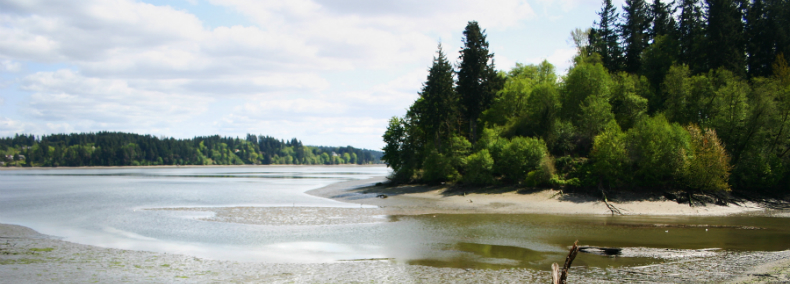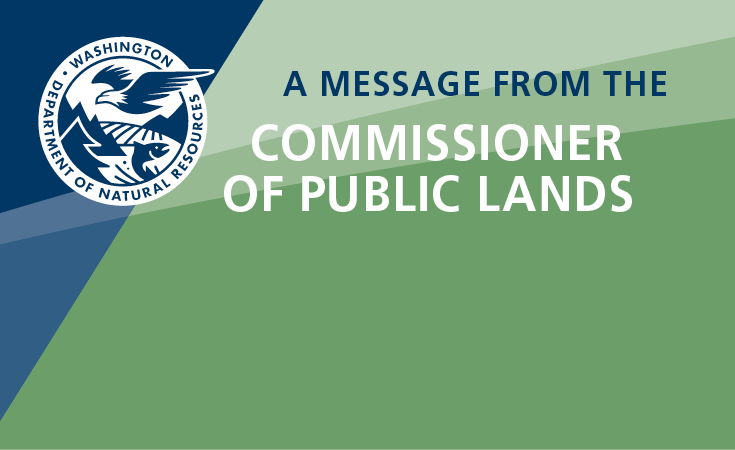Woodard Bay NRCA

Attention: Alerts and Closures
Recreation alert: The Overlook Trail is closed during the spring and summer months. More than 1,500 Double-Crested Cormorants and 100 Great Blue Herons are nesting in the trees above the trail. Walking under the nest trees disturbs the birds during this sensitive time in their life cycle. It is also not safe for people to be in the nesting area given the abundant fecal material that is raining down from the nesting trees. This material can cause respiratory diseases in birds and humans and we can inadvertently carry it to other bird colonies.
The Canoe Launch is open for the season until September 1. All other trails are open unless otherwise noted here.
Woodard Bay Natural Resources Conservation Area was designated by the legislature in 1987, one of the first in the state. A wildlife sanctuary that is just minutes from downtown Olympia, this 922-acre site protects habitat ranging from marine shoreline and wetlands to mature second growth forest. The site has a rich and varied human history that includes Native Americans, early settlers to southern Puget Sound and the logging and shellfish industries.
Woodard Bay provides habitat for shorebirds and songbirds, harbor seals, river otters, bald eagles, a large maternity colony of bats, and one of the most significant heron rookeries in the state. Three hiking trails are within the natural area: a paved road used as trail, a forested loop-trail, and another that is barrier-free, overlooking Woodard Bay. Trails may be closed seasonally to protect nesting herons and eagles.
Features protected: Five miles of undeveloped shoreline in Puget Sound, mature upland forests, freshwater wetlands, historic and cultural resources. (Thurston County)
Ecoregion: Puget Trough
Ecoregion: Puget Trough
Woodard Bay NRCA Management Plan (1.29KB PDF)
PLEASE STAY AWAY FROM THE SEALS!
DO NOT TOUCH, FEED OR DISTURB THE SEALS.
Seal pups need time ashore. Share the shore with Harbor Seal Pups. Their mothers will not return to feed them if people or dogs are nearby. If you observe that a seal pup has been stranded for more than 48 hours or is injured, please contact the Marine Mammal Stranding Network at (1-866-767-6114). Seals are protected from harassment under federal law. If you observe seals being disturbed by people or pets approaching them, please contact the NOAA Enforcement Hotline at (1-800-853-1964).
PLEASE STAY AWAY FROM THE BATS!
KEEP A 50 FOOT DISTANCE FROM THE PIER AND DO NOT ENTER.
The pier is an important nursery roost for little brown and Yuma myotis bats. Please help keep bats safe by giving them space. Bat roosts are protected by law. (WAC 220-200-100)
Nursery colonies include female bats who give birth and raise a single young (pup) each year between May and August. This is a vulnerable time for bats, and human disturbance can cause them to abandon their pups or roosts, and even death. These bats are an important part of the ecosystem, and they provide insect control by eating their body weight in insects each night.
Environmental Education and Public Access
Woodard Bay Natural Resources Conservation Area (NRCA) is a popular destination for environmental education, offering interpretive signs, interpretive shelter, historical interpretive structure, and three hiking trails. Frequent visitors include kindergarten through 12th grade students and higher education classes. The site provides opportunities for visitors to learn about native wildlife species and native forest, nearshore and wetland ecosystems. For information on educational opportunities and for tours with groups larger than 10 people please contact South Puget Sound Region, Natural Areas Manager.
- No pets allowed to help conserve the ecology of this site.
- Garbage service is not provided. Pack out what you pack in.
- Day use only.
Recreation alert: To protect nesting birds, the Overlook Trail is closed seasonally each year. The kayak launch is closed September 1 - April 15 each year.
Science, Research and Monitoring
Public and private universities, other research institutions or individual researchers may contact DNR to propose a research project at the site. If you are interested in pursuing research at Woodard Bay NRCA, please contact David Wilderman, Natural Areas Ecologist at david.wilderman@dnr.wa.gov
Examples of research and monitoring projects
- Woodard Bay NRCA was one of four locations included in a 2018 'bioblitz' project to inventory neashore invertebrate fauna in the south Puget Sound: http://pacshell.org/pdf/BioBlitz_Poster.pdf.
- 2009 SPS Observation Report
- 2008 Purple Martin Monitoring (Capital High School Senior Project)
- 2007 Olympia Oyster Restoration
Volunteer and Stewardship Opportunities
DNR hosts several volunteer work days at Woodard Bay NRCA throughout the year. For upcoming volunteer and stewardship opportunities, please contact Michele Zukerberg, DNR Natural Areas Manager at 360-902-1417.
Restoration at Woodard Bay NRCA
From the 1920s until the 1980s, when the site was legislatively designated as an NRCA, Woodard Bay was operated by Weyerhaeuser Co. as a log transfer facility. The creosote-laden remnants of the industrial structures have been providing habitat for important wildlife species like bats, seals, herons and cormorants. However, the structures also obstruct important nearshore processes and contribute to the degradation of water quality. DNR partnered with several organizations to complete a sediment characterization and feasibility study to develop ecosystem process-based restoration alternatives for the aquatic environment at the site. The study prioritized protection for important species present at the site including bats, seals, Olympia oysters, shorebirds and waterfowl.
Restoration was completed in 2013 and included the following actions:
- Removal of 2100 tons of creosoted-material including:
- Woodard Bay Trestle
- 50% of the Chapman Bay Pier
- 600 anchor pilings from Henderson Inlet
- Removal of 12,000 cubic yards of fill from Woodard Bay
- Installation of 50 nesting boxes for purple martins
- Restoration of 30 acres of riparian and upland habitat
Project Partners
- Washington Department of Fish and Wildlife
- Washington State Recreation and Conservation Office
- South Puget Sound Salmon Enhancement Group
- Squaxin Island Tribe
- The Nature Conservancy
- US Army Corps of Engineers
- Washington Department of Ecology
Attachments and Links
- Woodard Bay Restoration Feasibility Study (Windward Environmental LLC)
- Woodard Bay Sediment Characterization, Final Assessment Report (SAIC) and Appendices
- Boomtime - A history of the Woodard Bay NRCA
Directions to the Site
From Olympia: Travel north on East Bay Drive, which becomes Boston Harbor Road. Turn right onto Woodard Bay Road. Travel about ~ 1.5 miles and the road jogs to the left then picks up again to the right. Follow Woodard Bay Rd to the bottom of the hill. The parking area is on your left, just before the bridge.
From I-5 Southbound: Follow I-5 towards Olympia. Take Exit 109 (Martin Way Exit) towards Sleater-Kinney Road. Turn right onto Sleater-Kinney Rd NE. Travel approximately 4.5 miles then continue straight onto 56th Ave NE for 0.4 miles. At "T" turn right onto Shincke Rd NE going 0.5 mi. The road curves to the left and becomes Woodard Bay Rd NE then it curves to the right. Cross the bridge over Woodard Bay and the parking lot is on your right.
From I-5 Northbound: Take I-5 north to the Port of Olympia exit. Travel north on Plum St., which becomes East Bay Dr and then Boston Harbor Rd. Turn right onto Woodard Bay Road. Travel about ~ 1.5 miles and the road jogs to the left then picks up again to the right. Follow Woodard Bay Rd to the bottom of the hill. The parking area is on your left, just before the bridge.
A Washington State Discover Pass is required for parking at this site. This funding helps DNR manage these important natural areas across the state.


